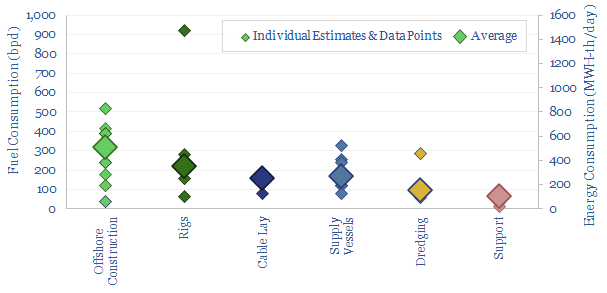This database tabulates the typical fuel consumption of offshore vessels, in bpd and MWH/day. We think a typical offshore construction vessel will consume 300bpd, a typical rig consumes 200bpd, supply vessels consume 150bpd, cable-lay vessels consume 150bpd, dredging vessels consume 100bpd and medium-sized support vessels consume 50bpd. Examples are given in each category, with typical variations in the range of +/- 50%.
This data-file tabulates the typical fuel consumption for different types of offshore vesesel, across all of our research into the offshore and shipping industries.
Offshore construction vessels are especially used in the offshore wind industry, where installation costs for a large-scale wind project will average aroud $1,000/kW spread across 60-100 vessels during peak activity. The largest are offshore construction vessels which will tend to consume around 300bpd of fuel. This is also factored in our EROEI calculations for a wind turbine.
Cable lay vessels are also used in offshore wind and more broadly amidst the expansion of power grids and HVDC interconnectors. We think a typical cable lay vesel will consume 150bpd of fuel.
Offshore rigs also see a continued role in our energy balances, in order to provide 85Mbpd of long-term oil demand and 800 bcfd of long-term gas demand in our roadmap to net zero. A typical offshore oil rig consumes 200bpd of fuel. The numbers are lower for jack-ups and ultra-efficient drillships, but can be higher for larger and older semi-subs.
Elsewhere in our shipping research, we see the typical fuel consumption of a large container ship at 1400bpd, a bulk tanker at 420bpd and a LNG carrier at 270bpd.
The fuel consumption of dredging vessels and the fuel consumption of platform supply vessels (PSVs) are also covered in the data-file of offshore vessels’ fuel consumption.
Please download the data-file for additional datapoints into the fuel consumption of different ships, and individual data-points that led us to these numbers.
